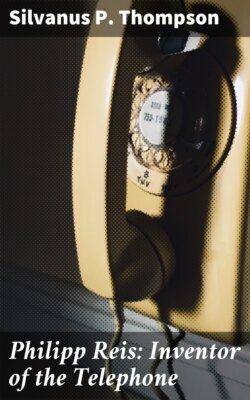Читать книгу Philipp Reis: Inventor of the Telephone - Silvanus P. Thompson - Страница 6
На сайте Литреса книга снята с продажи.
First Form.—The Model Ear.
ОглавлениеNaturally enough the inventor of the Telephone began with crude and primitive[3] apparatus. The earliest form of telephone-transmitter now extant, was a rough model of the human ear carved in oak wood, and of the natural size, as shown in Figs. 2, 3, 4, & 5.
Fig. 2.
Fig. 3.
Fig. 4.
Fig. 5.
The end of the aperture a was closed by a thin membrane b, in imitation of the human tympanum. Against the centre of the tympanum rested the lower end of a little curved lever c d, of platinum wire, which represented the “hammer” bone of the human ear. This curved lever was attached to the membrane by a minute drop of sealing-wax, so that it followed every motion of the same. It was pivoted near its centre by being soldered to a short cross-wire which served as an axis; this axis passing on either side through a hole in a bent strip of tin-plate screwed to the back of the wooden ear. The upper end of the curved lever rested in loose contact against the upper end g of a vertical spring, about one inch long, also of tin-plate, bearing at its summit a slender and resilient strip of platinum foil. An adjusting-screw, h, served to regulate the degree of contact between the vertical spring and the curved lever. The conducting-wires by which the current of electricity entered and left the apparatus were connected to the screws by which the two strips of tin-plate were fixed to the ear. In order to make sure that the current from the upper support of tin should reach the curved lever, another strip of platinum foil was soldered on the side of the former, and rested lightly against the end of the wire-axis, as shown in magnified detail in Fig. 6. If now any words or sounds of any kind were uttered in front of the ear the membrane was thereby set into vibrations, as in the human ear. The little curved lever took up these motions precisely as the “hammer”-bone of the human ear does; and, like the “hammer”-bone, transferred them to that with which it was in contact. The result was that the contact of the upper end of the lever was caused to vary. With every rarefaction of the air the membrane moved forward and the upper end of the little lever moved backward and pressed more firmly than before against the spring, making better contact and allowing a stronger current to flow. At every condensation of the air the membrane moved backwards and the upper end of the lever moved forward so as to press less strongly than before against the spring, thereby making a less complete contact than before, and by thus partially interrupting the passage of the current, caused the current to flow less freely. The sound waves which entered the ear would in this fashion throw the electric current, which flowed through the point of variable contact, into undulations in strength. It will be seen that this principle of causing the voice to control the strength of the electric current by causing it to operate upon a loose or imperfect contact, runs throughout the whole of Reis’s telephonic transmitters. In later times such pieces of mechanism for varying the strength of an electric current have been termed current-regulators.[4] It would not be inappropriate to describe the mechanism which Reis thus invented as a combination of a tympanum with an electric current-regulator, the essential principle of the electric current-regulator being the employment of a loose or imperfect contact between two parts of the conducting system, so arranged that the vibrations of the tympanum would alter the degree of contact and thereby interrupt in a corresponding degree the passage of the current.
Fig. 6.
Mr. Horkheimer, a former pupil of Reis, informs me that a much larger model of the ear was also constructed by Reis. No trace of this is, however, known.
